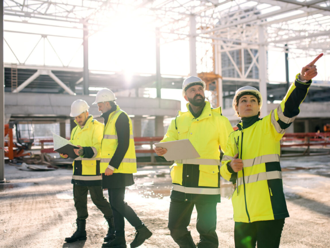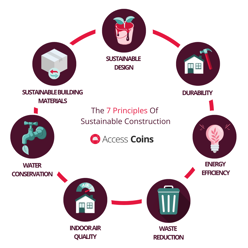Sustainability in Construction – A Complete Guide
Sustainability is no longer just a buzzword in construction, it’s a necessity.
As one of the largest contributors to carbon emissions, waste production, and resource consumption, the Australian construction industry is facing mounting pressure to adapt sustainable practices.
According to the Green Building Council of Australia (GBCA), the built environment is responsible for around 25% of Australia’s emissions. With the nation’s commitment to net zero by 2050, the construction sector must take urgent action to improve sustainability and reduce its environmental impact.
As pressure mounts from government regulations, investors, and the public, construction businesses must now adopt more sustainable practices to future-proof their operations.
In this guide, we’ll explore some of the key sustainability standards shaping Australian construction, the principles of sustainable building, and practical ways construction businesses can embed sustainability into their projects.
What is Sustainability in Construction?
Sustainability in construction is about reducing the environmental impact of construction and demolition while maintaining economic and social responsibility.
From using energy-efficient materials to adopting circular economy principles such as deconstruction, the phrase ‘sustainability’ covers a wide range of strategies that can help meet environmental demands, as well as improving both project outcomes and long-term business resilience.

Key Sustainability and Environmental Standards in Australian Construction
The Australian construction industry is subject to a growing number of regulations and frameworks aimed at reducing environmental impact and improving sustainability.
Understanding these standards is essential for contractors, developers, and project managers looking to remain compliant and enhance their sustainability credentials.
The National Construction Code (NCC) – Energy Efficiency Standards
The National Construction Code (NCC) sets out minimum requirements for energy efficiency in residential and commercial buildings across Australia.
Recent updates to the NCC 2022 increase the minimum energy efficiency rating for new homes to 7 stars under the Nationwide House Energy Rating Scheme (NatHERS). These changes support Australia’s Net Zero 2050 goal, driving improvements in insulation, glazing, and energy-efficient building services such as heating and cooling systems.
Green Star – Sustainability Certification for Buildings
Administered by the Green Building Council of Australia (GBCA), Green Star is one of the nation’s leading sustainability rating systems.
It assesses new and existing buildings across multiple criteria, including energy efficiency, water use, materials, indoor environmental quality, and emissions reduction.
A Green Star-rated building can enhance asset value, reduce operational costs, and support ESG (Environmental, Social, and Governance) reporting.
The Trajectory for Low Energy Buildings – Towards Net Zero
The Trajectory for Low Energy Buildings is a national plan designed to improve the energy efficiency of new and existing buildings while moving towards net zero energy consumption.
The initiative influences updates to the NCC and state-based regulations, encouraging the uptake of renewable energy, high-performance building materials, and energy-efficient design practices.
IS Rating Scheme – Sustainability for Infrastructure Projects
The Infrastructure Sustainability Council (ISC) administers the Infrastructure Sustainability (IS) Rating Scheme, which provides a national framework for assessing sustainability in infrastructure projects.
The IS Rating covers whole-of-life carbon management, resource efficiency, social sustainability, and governance practices, ensuring that major infrastructure developments align with environmental and climate resilience goals.
State and Territory-Based Sustainability Requirements
In addition to national standards, each Australian state and territory has its own sustainability requirements. Therefore, it is critical that you conduct independent research to familiarise yourself with these local standards as and when the need arises. Some notable examples include:
- Victoria's Environmentally Sustainable Development (ESD) framework, influencing planning and construction policies.
- New South Wales BASIX (Building Sustainability Index), which mandates energy and water efficiency for residential developments.
- Queensland’s Climate Action Plan, which supports sustainable building practices and net zero goals.
ESG Reporting and Sustainability Compliance in Australian Construction
Sustainability is no longer just about meeting environmental targets; it’s also a financial and reputational concern. More construction businesses are now required to report on their sustainability performance under ESG (Environmental, Social, and Governance) frameworks.
Investors, clients, and regulators increasingly expect transparency in areas such as:
- Carbon footprint reduction strategies
- Social value and ethical supply chain management
- Biodiversity and environmental impact mitigation
Mandatory Sustainability Reporting In Australia
Starting 1 January 2025, The Australian Government enacted its promised mandate on mandatory sustainability reporting in Australia. Whilst the current criteria only affects larger construction companies, by 2027 it is expected that this will begin to affect the entire sector. These reports are designed to ensure companies are accurately and routinely tracking their emissions, whilst also outlining plans to tackle future risks.
Why These Standards Matter
Keeping up with sustainability standards isn’t just about compliance, it’s about staying competitive in a rapidly evolving industry. Contractors and developers who embrace these frameworks have proven that they are able to reduce project risks, lower costs, attract investment, and future-proof their businesses against regulatory changes.
By understanding and integrating these sustainability standards into your projects, construction businesses can not only become more environmentally conscious but also build stronger reputations and more profitable businesses.
The Importance of Sustainability in Construction
Reducing Environmental Impact
The construction sector is responsible for around 40% of global carbon emissions, with energy use, material production, and transportation contributing heavily to climate change.
Additionally, construction generates vast amounts of waste—over 29 million tonnes annually in Australia. Sustainable construction practices, such as using low-carbon materials, energy-efficient design, and waste reduction strategies, help minimise this impact and contribute to both national and global Net Zero targets.
Regulatory and Legal Compliance
With the Australian government committed to achieving Net Zero by 2050, stricter regulations around sustainability continue to emerge.
From the National Construction Code (NCC) energy efficiency requirements to Green Star and BASIX, compliance with sustainability standards is now a legal and commercial necessity.
Companies that fail to meet these requirements risk fines, legal challenges, and project delays, while those who stay ahead of regulations can gain a competitive edge in securing contracts.
Cost Savings and Efficiency Gains
Making sustainability a priority in your construction projects leads to long-term cost savings. Energy-efficient buildings have lower operational costs, while smart resource management minimises waste and maximises efficiency. Strategies such as:
- Offsite and modular construction reduce material waste and labour costs.
- Renewable energy integration (solar panels, heat pumps) cuts ongoing energy expenses.
- BIM and digital construction technologies help optimise resource use and streamline project execution.
Meeting Client and Investor Expectations
Sustainability has quickly become a business differentiator in the Australian construction sector. Investors, developers, and clients are prioritising green construction due to rising ESG (Environmental, Social, and Governance) commitments.
- Major developers and public sector projects often require Green Star-certified or net-zero buildings.
- Private clients are demanding low-carbon, energy-efficient properties to reduce operational costs.
- Investors favour firms with strong sustainability credentials, improving access to funding and partnerships.
Futureproofing Against Market Shifts
The construction industry is evolving, with sustainability playing a central role in its future. Companies that adopt sustainable practices now will be better positioned for future success, avoiding the risks of falling behind in a rapidly changing market.
- Governments are phasing out high-carbon materials and processes.
- Clients are demanding circular economy solutions that reuse and recycle materials, such as deconstruction.
- Technologies like AI-driven sustainability planning and carbon tracking software are quickly becoming industry standards.

The 7 Principles of Sustainability in Construction
The seven principles of sustainable construction were introduced to the industry as a direct result of recent reports such as the ‘building to net zero’ scheme and The Paris Agreement of 2015.
These seven principles of sustainable construction provide a framework for the built environment, offering guidance on how achieve a greener construction sector by reducing the industry’s overall carbon footprint.
The 7 Principles of Sustainable Construction are:
- Sustainable Design
- Durability
- Energy Efficiency
- Waste Reduction
- Indoor Air Quality
- Water Conservation
- Sustainable Building Materials
Whilst these principles aren’t governed or mandated, the seven principles of sustainable construction provide a comprehensive framework for guiding efforts towards a greener built environment.
They serve as a great way to get businesses on-board with sustainable practices who are seeking guidance on how to both reduce carbon footprints and stay competitive in a rapidly evolving industry.
Sustainable Design
Also known as ‘green design’, this process refers to the practice of designing with the intention of minimising or circumventing negative environmental impact.
This not only aligns with the sectors net-zero objectives but also presents compelling long-term advantages for businesses. These can include substantial project savings in terms of costs, energy consumption, and even reduced labour when done correctly.
To navigate this landscape, established methodologies like Green Star offer invaluable guidance to architects and contractors alike.
By aligning yourself with third-party assessors in the early stages, businesses can work towards planning and specifying projects that consider:
- Energy Efficiency
- Water Conservation
- Sustainable Materials
- Social Equity
- Waste Reduction
Durability
Building with durability in mind, might at first glance seem like common sense, and you would be right in thinking so. However, as the industry’s perspective shifts towards retrofitting and away from new builds, it’s never been more important.
This principle emphasises the use of robust materials and construction techniques that can withstand the test of time. By prioritising durability, we ensure that both new and existing structures remain resilient, reducing the need for frequent maintenance and replacements.
This includes the use of materials designed to withstand weathering, corrosion and degradation, as well as being able to support high foot-traffic or extended use.
Energy Efficiency
This principle refers to the design strategies and techniques used to minimise energy use during the planning, build and ongoing upkeep of any building or construction project.
It can also refer to the transportation of personnel and materials and their lifecycle before reaching the site.
In Australia, the National Construction Code (NCC) energy efficiency provisions set the minimum standards for reducing energy use in buildings. Recent updates to the NCC 2022 energy efficiency standards aim to improve the thermal performance of homes and support the transition to net-zero energy buildings.
For example, new residential buildings in many states must now achieve a 7-star energy rating under the Nationwide House Energy Rating Scheme (NatHERS), ensuring better insulation, passive design, and energy efficiency from the outset.
Designing around energy efficiency
In Australia, energy efficiency assessments are conducted through NatHERS ratings and the BASIX (Building Sustainability Index) framework in New South Wales. These assessments evaluate:
- Thermal performance (insulation, glazing, and ventilation)
- Operational energy consumption (heating, cooling, and lighting)
- Renewable energy integration (such as solar PV systems)
Waste Reduction
Waste reduction refers to the continued implementation of processes and strategies that minimise waste during the entire construction of a project. It promotes the need for recycling and the use of recycled materials, whilst also dissuading new-builds where possible.
Unfortunately, an industry-wide philosophy of ‘demolish and start again’ has led to a culture which frequently overlooks the importance of a circular construction process.
By focusing on retrofits, adhering to the waste management hierarchy (Reduce. Reuse. Recycle. Dispose) we have the means to ensure we are minimising waste.
Indoor Air Quality
Sustainable design and construction should also aim to improve indoor air quality to promote healthy and comfortable indoor environments.
With climate control system surging in popularity, natural ventilation, has for the longest time been overlooked and ignored.
Whilst the feasibility of effective natural airflow and ventilation will always be location-specific, there are several design features that can aid in improving indoor air quality and airflow. Specifying systems such as solar chimneys, wind towers, ridge vents, high louvres, transoms & clerestories can help improve the air quality of our inhabited spaces.
Water Conservation
The construction sector is infamous not only for its high level of energy use, but also its water consumption. To become greener, many in the construction industry have developed new processes for more sustainable use of water throughout the building process.
Minimising the use of water during the material production process or building process will vary from business to business, however some useful ways to reduce water consumption include:
- Low-Flow Fixtures
- Rainwater Harvesting Systems
- Efficient Irrigation
- Regular Maintenance and Leak Detection
- Monitoring, Reporting and Improving Water Use
Sustainable Building Materials
Sustainable building materials includes all products that are selected, produced and integrated efficiently to minimise environmental impact.
This includes using materials that have been created using renewable or recycled materials, produced with minimal waste output and those that are designed for long-term use and reusability.
However, adopting this final sustainability principle, requires the industry to shift their perspective and end bad habits. Seeking new products and being more environmentally aware begins with making changes to the way we specify.
Some examples of sustainable alternatives to materials already being used to great success in the industry include:
- Approved Timber
- Natural Fibre Reenforced Concrete
- Geo-Textiles Using Natural Fibres
- Carbon-Sequestering Materials
How Sustainability Can Be Incorporated into Construction Projects
With so much info out there, it can be hard to know how to apply all these sustainable methodologies into real-world construction projects.
From planning and design to material selection and waste management, adopting sustainable methods can sometimes feel like you’re being made to jump through hoop after hoop.
To put it all into context, here are some key ways sustainability can be integrated into construction projects.
Sustainable Planning & Design
Sustainability should be considered from the earliest stages of a project to minimise environmental impact and optimise efficiency. Key strategies include:
- Site selection: Choosing brownfield sites over greenfield to reduce land disruption.
- Energy modelling and simulation: Using digital tools like BIM (Building Information Modelling) to forecast energy consumption and optimise designs.
- Multi-functional spaces: Designing buildings that can be easily repurposed in the future, reducing demolition waste.
Choosing Sustainable Building Materials
Material selection plays a crucial role in reducing the embodied carbon footprint of a project. Sustainable material choices include:
- Low-carbon concrete alternatives (e.g., geopolymer concrete, recycled aggregate concrete).
- Sustainably sourced timber, such as FSC-certified wood.
- Recycled and reclaimed materials (e.g., steel, bricks, insulation materials).
- Bio-based materials, including hempcrete and mycelium-based insulation.
- Modular and prefabricated components, which reduce onsite waste and improve efficiency.
Energy-Efficient Construction Methods
Reducing operational carbon emissions is just as important as minimising embodied carbon. Incorporating energy-efficient strategies into construction can significantly cut long-term energy use.
- Renewable energy integration: Installing solar panels, wind turbines, or heat pumps.
- LED lighting and smart systems: Using automation and sensors to optimise energy use.
- High-performance insulation and glazing: Reducing heating and cooling demands.
- Onsite renewable energy generation: Capturing and using energy within the project site to reduce reliance on fossil fuels.
Water Conservation Strategies
Construction projects can significantly reduce water consumption through smart design and resource management.
- Rainwater harvesting systems for non-potable uses such as irrigation and flushing.
- Greywater recycling to reuse water from sinks and showers.
- Low-flow fixtures and fittings to reduce water waste.
- Permeable surfaces and sustainable drainage systems (SuDS) to prevent urban flooding.
Waste Reduction and Circular Economy Principles
Construction and demolition waste make up a significant proportion of landfill waste. Sustainable waste management focuses on minimising and reusing materials.
- Lean construction techniques to reduce material overuse and inefficiencies.
- Offsite construction and prefabrication to reduce on-site waste.
- Deconstruction instead of demolition, allowing materials to be reclaimed and reused.
- Recycling programs to divert materials like concrete, wood, and metals from landfills.
Integrating Construction Technologies
Advancements in digital construction and smart technology are making it easier to track and improve sustainability performance.
- Building Information Modelling (BIM): Enables precise material planning, reducing waste.
- Enterprise Resource Planning (ERP) Software: Centralises your project data and automates workflows, enabling real-time monitoring of sustainability metrics, facilitating informed decision-making.
- Digital Twin Technology: Creates a virtual model to simulate a building’s performance and optimise sustainability.
Driving Sustainable Construction with Access Coins
Sustainability in construction isn’t just about choosing greener materials, it’s about improving efficiency, reducing waste, and making smarter decisions throughout a project’s lifecycle.
Access Coins helps construction firms achieve this by providing a centralised platform that streamlines project management, optimises resource allocation, and reduces costly rework that contributes to up to 20% of the industry’s carbon footprint.
With real-time data, automation, and advanced analytics, Access Coins helps construction teams track project and business data to support sustainable operations.
By supporting Modern Methods of Construction (MMC), including modular and prefabricated approaches, Access Coins also enables more sustainable building practices that lower carbon emissions.

 UK
UK
 SG
SG
 MY
MY
 US
US
 IE
IE

